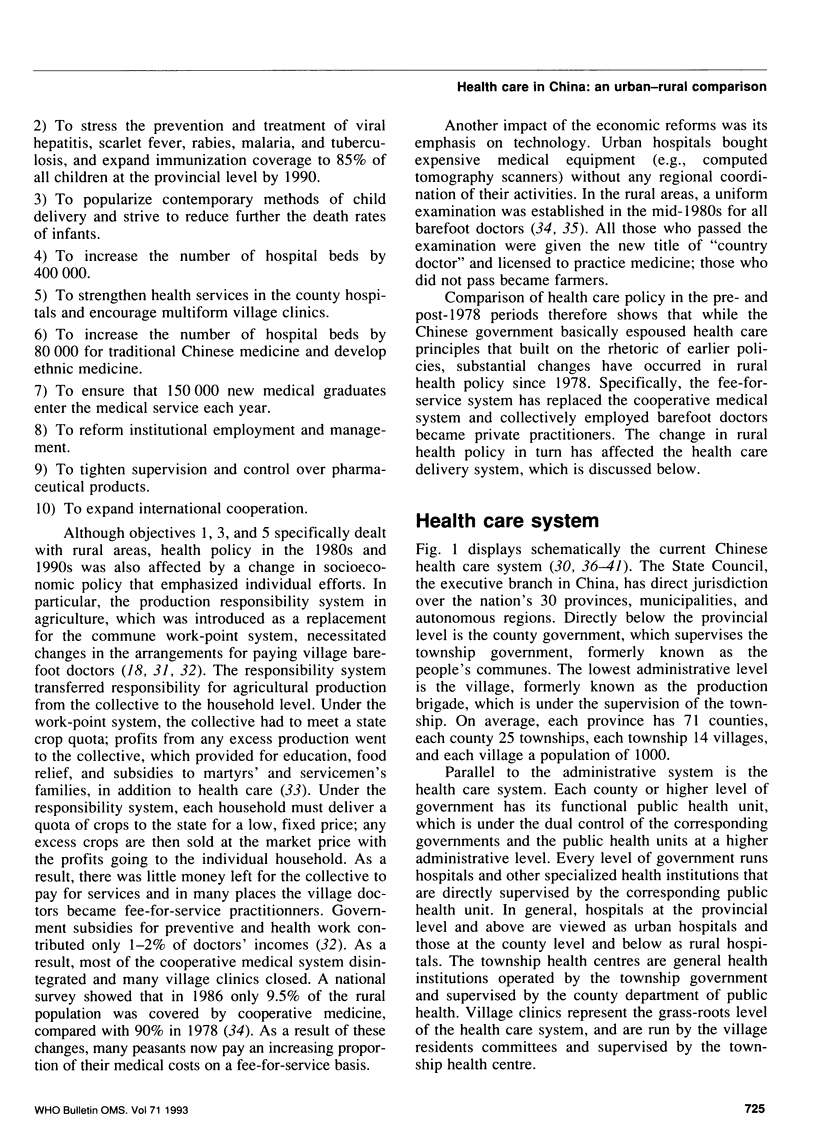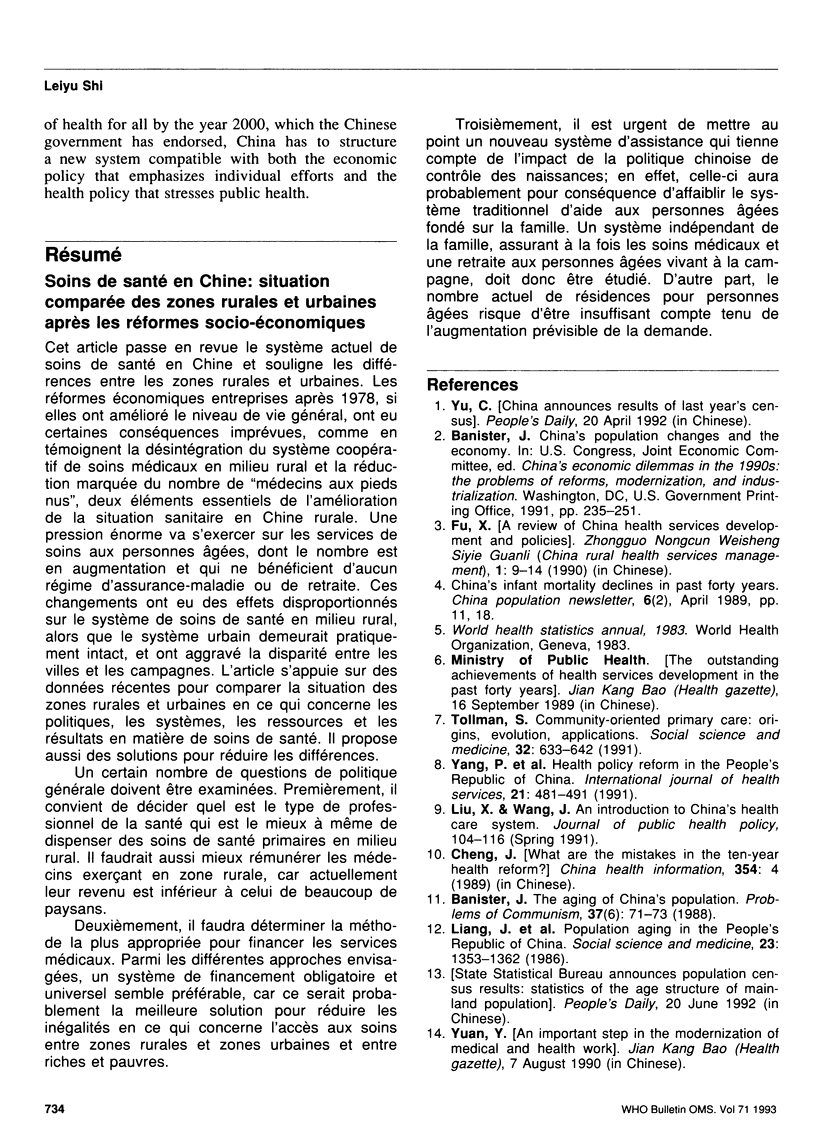Abstract
This article provides an overview of the current Chinese health care system with particular emphasis on rural-urban differences. China's post-1978 economic reforms, although they improved general living standards, created some unintended consequences, as evidenced by the disintegration of the rural cooperative medical system and the sharp reduction in the number of "barefoot doctors", both of which were essential elements in the improvement of health status in rural China. The increase in the elderly population and their lack of health insurance and pensions will also place enormous pressure on services for their care. These changes have disproportionately affected the rural health care system, leaving the urban system basically intact, and have contributed to the rural-urban disparity in health care. Based on recent data the article compares current rural-urban differences in health care policy, systems, resources, and outcomes, and proposes potential solutions to reduce them.
Full text
PDF













Selected References
These references are in PubMed. This may not be the complete list of references from this article.
- Cohen M. S., Hendersen G. E. Medical care in the People's Republic of China: access and cost. Ann Intern Med. 1983 Nov;99(5):727–728. doi: 10.7326/0003-4819-99-5-727. [DOI] [PubMed] [Google Scholar]
- Goldstein A., Goldstein S. The challenge of an aging population. The case of the People's Republic of China. Res Aging. 1986 Jun;8(2):179–199. doi: 10.1177/0164027586008002001. [DOI] [PubMed] [Google Scholar]
- Hardee-Cleaveland Karen, Banister Judith. Fertility policy and implementation in China, 1986-88. Popul Dev Rev. 1988 Jun;14(2):245–286. [PubMed] [Google Scholar]
- Henderson G. E., Cohen M. S. Heatlh care in the People's Republic of China: a view from inside the system. Am J Public Health. 1982 Nov;72(11):1238–1245. doi: 10.2105/ajph.72.11.1238. [DOI] [PMC free article] [PubMed] [Google Scholar]
- Hsiao W. C. Transformation of health care in China. N Engl J Med. 1984 Apr 5;310(14):932–936. doi: 10.1056/nejm198404053101428. [DOI] [PubMed] [Google Scholar]
- Huang S. M. Transforming China's collective health care system: a village study. Soc Sci Med. 1988;27(9):879–888. doi: 10.1016/0277-9536(88)90277-8. [DOI] [PubMed] [Google Scholar]
- Ikels C. Aging and disability in China: cultural issues in measurement and interpretation. Soc Sci Med. 1991;32(6):649–665. doi: 10.1016/0277-9536(91)90144-2. [DOI] [PubMed] [Google Scholar]
- Liang J., Tu E. J., Chen X. M. Population aging in the People's Republic of China. Soc Sci Med. 1986;23(12):1353–1362. doi: 10.1016/0277-9536(86)90298-4. [DOI] [PubMed] [Google Scholar]
- Ma E. One child, one family. JAMA. 1989 Mar 24;261(12):1735–1736. [PubMed] [Google Scholar]
- Mechanic D., Kleinman A. Ambulatory medical care in the People's Republic of China: an exploratory study. Am J Public Health. 1980 Jan;70(1):62–66. doi: 10.2105/ajph.70.1.62. [DOI] [PMC free article] [PubMed] [Google Scholar]
- New P. K., New L. M. The links between health and the political structure in New China. Hum Organ. 1975 Fall;34(3):237–251. doi: 10.17730/humo.34.3.c70648h2254w8631. [DOI] [PubMed] [Google Scholar]
- Prescott N., Jamison D. T. Health sector finance in China. World Health Stat Q. 1984;37(4):387–402. [PubMed] [Google Scholar]
- Sidel V. W. Medical care in China: equity vs modernization. Am J Public Health. 1982 Nov;72(11):1224–1226. doi: 10.2105/ajph.72.11.1224. [DOI] [PMC free article] [PubMed] [Google Scholar]
- Tollman S. Community oriented primary care: origins, evolution, applications. Soc Sci Med. 1991;32(6):633–642. doi: 10.1016/0277-9536(91)90142-y. [DOI] [PubMed] [Google Scholar]
- Yang P. L., Lin V., Lawson J. Health policy reform in the People's Republic of China. Int J Health Serv. 1991;21(3):481–491. doi: 10.2190/GGUT-K19W-FHUR-PPLF. [DOI] [PubMed] [Google Scholar]


